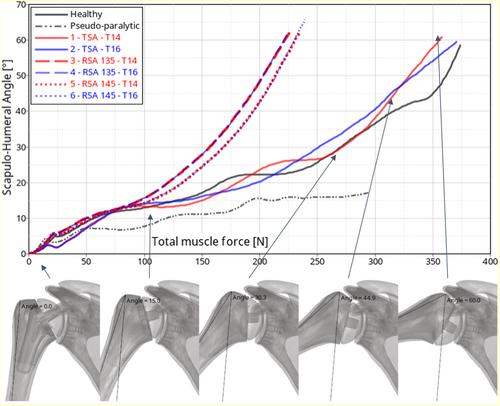Finite element analysis part 1 of 2: Influence of short stem implant polyethylene configuration on glenohumeral joint biomechanics
Abstract
Purpose
Stress shielding in short-stem arthroplasty can cause critical metaphyseal bone loss. If the size and shape of the humeral shaft are important factors, it is unknown whether the shape of the polyethylene component in reverse shoulder arthroplasty (RSA) affects bone stress around or within the stem. We explored the impact of polyethylene shape on humeral and scapular stress distribution using a finite element model.
Methods
We developed a shoulder-specific finite element model. A defined set of muscle forces was applied to simulate movements. An intact rotator cuff state and a superior deficient rotator cuff state were modelled. We used the FX V135 short stem in three conditions: total shoulder arthroplasty (TSA), and RSA with symmetrical and asymmetrical polyethylene (145°/135°). We measured biomechanical markers related to bone stress for different implant sizes. Joint kinematics and the mechanical behaviour of the implant were compared.
Results
Rupture of the supraspinatus muscle produced a functionally limited shoulder. The placement of an anatomic TSA with an intact rotator cuff restored function similar to that of a healthy shoulder. RSA in the rotator cuff-deficient shoulder restored function regardless of stem size and polyethylene shape. While stem size had an impact on the stress distribution in the bone and implant, it did not show significant potential for increasing or decreasing overall stress. For the same stem, stress distribution at the humerus is different between TSA and RSA. Polyethylene shape did not alter the transmission of stress to the bone in RSA. Asymmetric polyethylene produced a greater abduction range of motion.
Conclusions
In terms of bone stress distribution, smaller stems seemed more appropriate for TSA, while larger stems may be more appropriate for RSA. Polyethylene shape resulted in different ranges of motion but did not influence bone stress.
Level of Evidence
Diagnostic Tests or Criteria; Level IV.


 求助内容:
求助内容: 应助结果提醒方式:
应助结果提醒方式:


